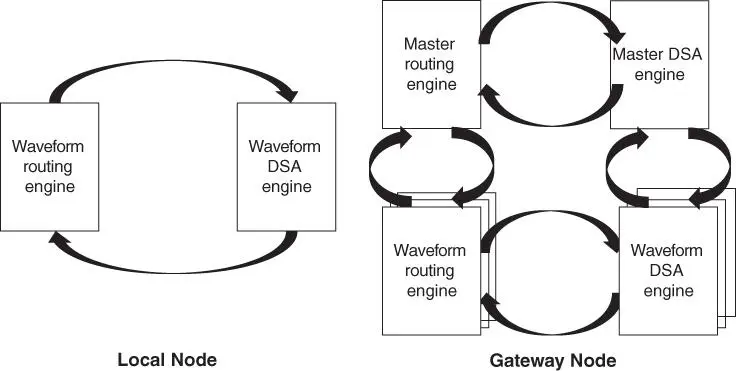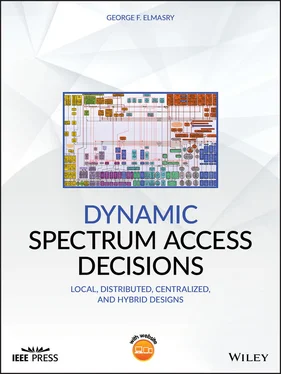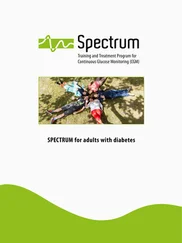In the previous section, we saw how a distributed DSA engine can interact with a distributed routing engine in order to create a low spectrum footprint MANET with antijamming, LPI/LPD, and dynamic spectrum reuse capabilities. In this section, we will show how this distributed cooperative routing engine concept, which is local to a single network, can be adapted to global heterogeneous routing, which is between the different types of hierarchical MANETs. 8The goal here is to explore how far a system that is designed as a hybrid between local and distributed cooperative DSA decisions can go before we move to cases where a centralized DSA arbitrator is needed.
Making distributed DSA work in a global manner with heterogeneous hierarchical networks can be based on the following principals:
The creation of multitiered DSA engine architecture where a platform that is a node of more than one network (gateway node) has a distributed DSA engine for each network and a parent DSA engine (for global arbitration of DSA decisions).
The creation of two distinct types of cognitive routing engines where one type is for routing local to the network and the other type is for gateway nodes that can create global routes.
For this multitiered architecture, let us refer to the lower tier DSA engine as the waveform DSA engine, the routing engine local to the network as the waveform routing engine, the upper tier DSA engine as the master DSA engine, and the upper tier routing engine as the master routing engine. Figure 4.6illustrates how a node that is not a gateway node would contain only the two waveform engines while a gateway node would contain all four types of engines with the lower tier engines (waveform DSA engine and waveform routing engine) having one separate engine for each waveform type the gateway node has. The master DSA engine and the master routing engine will always have a single instantiation in each gateway node.

Figure 4.6Local and gateway nodes cognitive engines.
Notice that there are different approaches used to create dynamic heterogeneous global routing. One known approach creates an interface control definition (ICD) between each waveform type and the networking layer above the waveform. This interface is sometimes referred to as the router‐to‐radios (R2R) interface. In Figure 4.6, this interface may be replaced with the interface between the waveform routing engine and the master routing engine. The approach covered here relies on the master routing engine making routing decisions by choosing between the different available paths based on the condition of each wireless network in the path. This interface can override R2R protocols such as the point‐to‐point protocol over Ethernet (PPPOE), which have been shown to be insufficient in dynamic MANETs. The approach covered here leaves certain dynamic spectrum management local to each network through the waveform DSA engine and uses the master DSA engine for other DSA decisions. Here, we have a more comprehensive approach than that of Section 4.3where the gateway node is part of the spectrum allocation negotiation between the different MANETs.
There are established methodologies that address getting statistics that convey the local MANET dynamics from the waveform (radio modem) to the routing layer above. These established methods assume that the wireless links below the routing layer have already been established. Protocols such as the dynamic link exchange protocol (DLEP) communicate metrics to include link quality, bandwidth, and neighbor discovery. With DLEP, the wireless links and communications with neighbors must be established before these metrics can be passed to a routing engine. As such, the master routing engine in the construct in Figure 4.6will not be able to make routing decisions that include an underlying waveform network unless radio links are established. The multitiered approach illustrated in Figure 4.6can generalize the DLEP a step further by having the master DSA engine (higher tier engine) perform proactive sharing of the node's links capabilities over a “control plane” medium even when some of the available wireless links are not in use (i.e., in a large scale heterogeneous network, some MANET links have not been formed yet). In the gateway node, the master routing engine is able to receive (via the master DSA engine) location, status, capabilities, and spectrum resources utilization information from peer remote radios engines before all link establishment occurs and use this information to establish potential routes. The master DSA engine is able to use this information to perform spectrum resources deconfliction, link closure estimates, and bandwidth estimation before these links are established. The DSA master engine's ability to perform proactive sharing over different waveforms (mediums), through the master routing engine already established routes, gives the master routing engine the ability to ascertain potential data rates to neighbors on each network type prior to the establishment of all wireless links to these neighbors.
Note that with this type of heterogeneous waveforms formation, the interface between the waveform DSA engine and the master DSA engine has to use unified wireless link metrics regardless of the waveform type which the waveform DSA engine represents. One waveform type may express the health of its wireless links in a different way from another waveform type. This multitiered architecture requires some normalization of the link health metrics calculated by the different waveforms in order for a routing engine to create an optimum global routing table without being skewed to use one waveform over another due to the lack of uniformity of link health metrics. This normalization should also allow the different networks to use different routing approaches internal to the formed MANET independent of global routes. One of the most important essences of creating true seamless efficient heterogeneous networks is to allow each network to use the best protocols for its internal routing and link health representation while requiring the different types of waveform DSA engines to adhere to a unified representation of the network metrics when it comes to global aspects.
Let us illustrate how this hierarchical architecture can work with the case of a low bandwidth waveform that has global connectivity over a specific deployment. This low bandwidth waveform can be used to create a large RF footprint MANET that is used to establish the control plane over the deployed large‐scale heterogeneous hierarchical MANETs. In addition to the low bandwidth global network, the theater deployment has different types of higher bandwidth waveforms that will establish different types of networks (e.g., mesh networks, omnidirectional multiple access networks, LPI/LPD directional networks, etc.) where spectrum resources can be allocated dynamically within these networks and utilized globally by the master routing engine. Let us refer to these higher bandwidth networks links as offload links. The goal of DSA in this construct is to use these offload links dynamically and on‐demand considering the following:
1 When data traffic to a node over the low bandwidth global network exceeds a defined threshold, the master routing engine will ask the master DSA engine to allocate resources over a specific higher bandwidth network. The master DSA engine will allocate the required spectrum resources by asking the corresponding waveform DSA engine to create a flow 9to that node. This action will create a new routing path for the master routing engine.
2 When data traffic levels exceed the currently allocated bandwidth, the master routing engine will ask the master DSA engine to increment the allocated resources. The master DSA engine will ask the corresponding waveform DSA engine to acquire more bandwidth over the established offload data link. The current waveform DSA agent might adjust allocations or the master DSA engine might switch to another offload link on another network as necessary to meet the traffic volume needs. In either case, the master DSA engine will inform the master routing engine if the created routing path has increased bandwidth or if a new routing path is created with the required bandwidth.
Читать дальше













